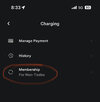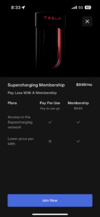The completely separate ports for AC and DC charging in CHAdeMO vehicles is incredibly clunky design, though.If Tesla was doing this as "a deliberate choice to enable a more ergonomic plug form factor" I would submit there was a already an existing system that provides that function without the failure mode complexity of AC/DC pin sharing using CHAdeMO for fast charging etc, ie keep AC/DC totally separate in individual ports that are "ergonomic" to use individually.
Welcome to Tesla Motors Club
Discuss Tesla's Model S, Model 3, Model X, Model Y, Cybertruck, Roadster and More.
Register
Install the app
How to install the app on iOS
You can install our site as a web app on your iOS device by utilizing the Add to Home Screen feature in Safari. Please see this thread for more details on this.
Note: This feature may not be available in some browsers.
-
Want to remove ads? Register an account and login to see fewer ads, and become a Supporting Member to remove almost all ads.
You are using an out of date browser. It may not display this or other websites correctly.
You should upgrade or use an alternative browser.
You should upgrade or use an alternative browser.
Tesla opening up the Supercharger network in Australia to other brand EVs.
- Thread starter TrevRex
- Start date
I guess that would be your opinion when in fact I have found it very easy to use from a users standpoint and from a designer's standpoint looking at failure modes, safety, complexity of the components needed for NACS etc when comparing NACS to CHAdeMO I would take what you call "is incredibly clunky design" any day of the week.The completely separate ports for AC and DC charging in CHAdeMO vehicles is incredibly clunky design, though.
LOL the one person here that supposedly lives "in my head" finds it's very interesting that I have no trouble plugging in CHAdeMO.Very interesting.
Please, please son keep bringing "in my head" those laughs you provide me.
Zoltrix77
Member
So just a visual on why CCS1 vs NACS is just a form factor issue, (CCS2 similar again but different form factor again).
Same five pins, just in a different form/positioning.
So slapping a NACS cable on a non-tesla DC fast charger is a trivial exercise. And it won't give you better reliability. That will still require an improvement in engineering and maintenance schedule.
I agree it won't help reliability that much, except for the fact that there are plenty of reports that you need to "hold the handle up and in" while the negotiation takes place on CCS1! So in that sense, NACS will help for out overseas brothers and sisters.
That being said, while reliability is great on Tesla, it will be interesting to see just how compatibility goes with other vehicles on the supercharger en-masse, Tesla has been dealing with only the perfect compatibility of its own vehicles thus far.
That being said, while reliability is great on Tesla, it will be interesting to see just how compatibility goes with other vehicles on the supercharger en-masse, Tesla has been dealing with only the perfect compatibility of its own vehicles thus far.
Well based on Plugshare comments, MGs often seem to have trouble on Tesla Superchargers. People seem to forget that DC fast charging is not just about hardware but also the software and handshaking/comms between car and stall.
Tesla SCs work so well for Tesla vehicles because Tesla designed both and only had to do testing against its own vehicles. Opening up SCs to other EV makes exposes where either Tesla has not tested against particular cars, or those cars have implemented the standard a slightly different way that causes problems. IoT is not a simple process and stuff will break.
You might think standards should be written so that there is zero ambiguity in how to implement it, and that is the intention, but since they are written by humans, there will always be something that is ambiguous, left unstated, could be interpreted in different ways, or was never thought of.
MGs seem to have the most trouble with all chargers - AC, DC, Tesla, other manufacturers...Well based on Plugshare comments, MGs often seem to have trouble on Tesla Superchargers.
paulp
Active Member
A relative of mine has a MG ZS. He only uses the MG mobile home charger and has never had an issue with it.MGs seem to have the most trouble with all chargers - AC, DC, Tesla, other manufacturers...
OK yes, that goes without saying, you would expect it to at least work with its own brand chargers.A relative of mine has a MG ZS. He only uses the MG mobile home charger and has never had an issue with it.
doggy1
Member
Yesterday I watched Bjorn's 1,000km challenge (I try to watch all of them) for the MG5. He had to abort it, in large part due to charging failures with the MG5. So I think MG's DC charging issues go well beyond interaction with Tesla Superchargers. Link here:MGs seem to have the most trouble with all chargers - AC, DC, Tesla, other manufacturers...
EcoCloudIT
Active Member
RichardV
Member
Not new. Was released at same time as opening to non-teslas. Gives non-teslas the same price as teslas but they pay the monthly fee.Is this new or I completely missed it from a while ago?
View attachment 949642
View attachment 949641
EcoCloudIT
Active Member
Not new. Was released at same time as opening to non-teslas. Gives non-teslas the same price as teslas but they pay the monthly fee.
So right now I could rock up in an Merc EQE and charge at a Tesla SC in "Australia"?
RichardV
Member
For the five superchargers open to non-teslas. In regional NSW. Check the Tesla web site, find us, and filter for only open to non-tesla superchargers.So right now I could rock up in an Merc EQE and charge at a Tesla SC in "Australia"?
Or look at the Supercharger - Australian Index thread right here, which has them marked.For the five superchargers open to non-teslas. In regional NSW. Check the Tesla web site, find us, and filter for only open to non-tesla superchargers.
It's very likely that all the "Drive NSW" grant funded sites will also end up open to all comers as well.
B3AU
Member
And hopefully every other supercharger soon enough ;-)Or look at the Supercharger - Australian Index thread right here, which has them marked.
It's very likely that all the "Drive NSW" grant funded sites will also end up open to all comers as well.
Eg, the Runaway Bay Centre in QLD who recently got a supercharger has posted on Facebook that its Tesla's intention to open their chargers by the end of the year Supercharger - Runaway Bay, Qld
B3AU
Member
Happy days, the Superchargers open to Non-Tesla EVs has increased from the initial 5 sites.
From a quick glance, Campbelltown is 78c/kWh without membership (63c/kWh with membership)
From Tesla's Country Manager for Australia on LinkedIn - Thom Drew on LinkedIn: Tesla opens 30 Superchargers to rival electric cars in Australia

New South Wales
- Bathurst
- Berry
- Blaxland
- Campbelltown
- Dubbo
- Hollydene
- Knockrow
- Narooma
- Tamworth
- Tenterfield
- Wollongong
Victoria
- Bendigo
- Box Hill
- Cann River
- Colac
- Geelong
- Moe
- Mornington
- Shepparton
- Warrnambool
- Yea
Queensland
- Gympie
- Rochedale
- Toowoomba
Western Australia
- Margaret River
- Williams
South Australia
- Clare
- Mount Gambier
- Tailem Bend
Australian Capital Territory
- Tuggeranong
From a quick glance, Campbelltown is 78c/kWh without membership (63c/kWh with membership)
From Tesla's Country Manager for Australia on LinkedIn - Thom Drew on LinkedIn: Tesla opens 30 Superchargers to rival electric cars in Australia
Last edited:
Looks like they've excluded the most busy chargers - Campbelltown is the only one on the Hume Hwy, and Knockrow the only one on the Pacific Hwy. There's plenty of third-party sites on those routes anyway.
This includes all the open sites with NSW Government funding.
This includes all the open sites with NSW Government funding.
Last edited:
Zoltrix77
Member
Will be interesting to see how it pans out over the summer break. They need to at least deploy the V4 style stalls with long cables. Would be a 'relatively' cheap upgrade to avoid multiple stall blocking issues.
moa999
2020 3 SR+ MSM
It will be interesting to see what Tesla does.
At the NSW Govt funded V3 sites (currently Blaxland, Campbeltown and Wollongong Figtree), I wouldn't be surprised to see a few V4 (or V3.5 stalls) replace the V3 - to add the supposedly required contactless payment and provide longer cables. You probably only need to do this at two stalls.
I say V3.5 because afaik true V4 also needs a cabinet upgrade to support 800-1000V charging
(Which might only be needed for the CT in the Tesla universe for a while and thus possibly US/Canada only).
Query if such a stall retrofit is possible at the older V2 sites.
At the NSW Govt funded V3 sites (currently Blaxland, Campbeltown and Wollongong Figtree), I wouldn't be surprised to see a few V4 (or V3.5 stalls) replace the V3 - to add the supposedly required contactless payment and provide longer cables. You probably only need to do this at two stalls.
I say V3.5 because afaik true V4 also needs a cabinet upgrade to support 800-1000V charging
(Which might only be needed for the CT in the Tesla universe for a while and thus possibly US/Canada only).
Query if such a stall retrofit is possible at the older V2 sites.
Also Tenterfield.At the NSW Govt funded V3 sites (currently Blaxland, Campbeltown and Wollongong Figtree)
Similar threads
- Replies
- 11
- Views
- 1K
- Replies
- 59
- Views
- 3K
- Replies
- 4
- Views
- 231




